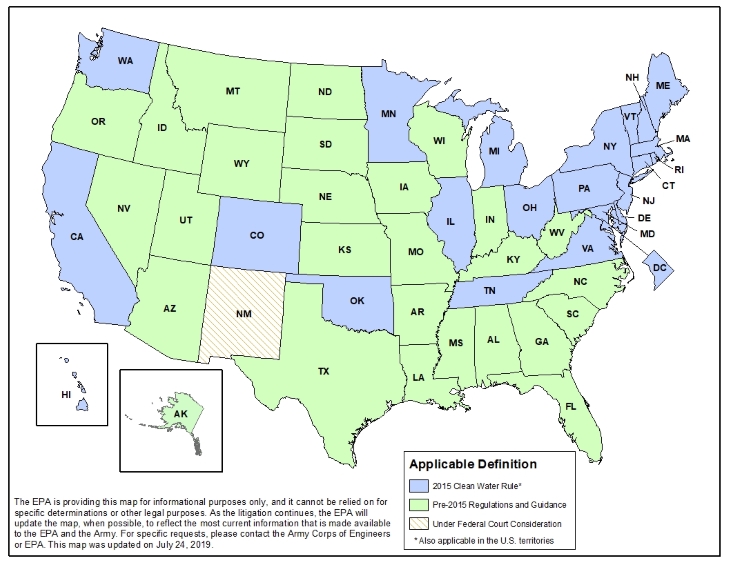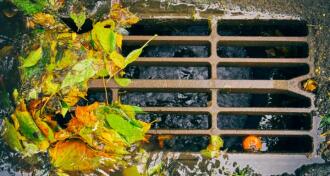We are on the eve of a new regulatory definition of "waters of the United States" for the Clean Water Act.
The United States Environmental Protection Agency ("EPA") and Army Corps of Engineers ("Corps") completed step one of the two-step "repeal and replace" process ordered by President Trump in 2017 by finalizing a new rule on September 12, 2019, to repeal the 2015 Clean Water Rule (the "Clean Water Rule").
How Did We Get Here?
Since 1972 the Clean Water Act ("Act") has prohibited the unpermitted discharge of pollutants and dredged and fill materials into navigable waters. "Navigable waters" is defined in the Act as "waters of the United States, including the territorial seas," but Congress has never defined "waters of the United States" ("WOTUS"). For the last 40 years, the EPA, the Corps, the courts, and the regulated public have grappled with exactly what waters are subject to federal jurisdiction.
In the early 2000s, two Supreme Court decisions expanded the interpretation of WOTUS from its then-accepted definition—rivers, lakes, coastal waters, tributaries, and wetlands that affect interstate commerce—to include those waters with considerably less direct subsurface connection to traditional navigable waters. One of these decisions, Rapanos v. United States (2006), was decided by a split court with no controlling opinion. The lower courts, the EPA, and the Corps routinely began following now-retired Justice Anthony Kennedy's concurring opinion rather than the plurality opinion by the late Justice Antonin Scalia. Justice Kennedy's lone opinion advocated use of a "significant nexus" test—that jurisdiction under the Act extends to bodies of water and wetlands, alone or combined with other similarly situated lands that significantly contribute to the chemical, physical, and biological integrity of traditional navigable waters. But the application of this significant nexus test on a case-by-case basis to waters in different states across the country led to inconsistent and unpredictable results for the regulated community.
To minimize these case-by-case evaluations and provide predictability for the frustrated, and often outraged, regulated community, the EPA and the Corps under the Obama Administration published the Clean Water Rule in August 2015, which provided a WOTUS definition, which we covered in an earlier article. But the Clean Water Rule barely made it out of publication before challenges were filed across the country--by states and industry groups that saw the Clean Water Rule as government overreach and by environmental interest groups that saw it as failing the Act's protective goals. By October 2015, there was a nationwide stay halting the application of the Clean Water Rule. The stay was vacated in early 2018, but the confusion remained: twenty-two states now follow the Clean Water Rule while the remaining 28 follow the pre-2015 regulations and guidance that came out of Rapanos.
Two Steps Forward, One Step Back
On February 28, 2017, President Trump issued an Executive Order directing the EPA and the Corps to review and then either rescind or revise the Clean Water Rule. Out of that Order, the EPA and the Corps developed a two-step process: Step One – Repeal, and Step Two – Replace.
For Step One, the EPA and the Corps, in February 2018, suspended implementation of the Clean Water Rule until 2020. But this effort, often called the Applicability Rule or the Suspension Rule, was immediately challenged and struck down in two federal courts. The agencies appealed.
Meanwhile, for Step Two, the agencies crafted a new definition of WOTUS, interpreting the term as expressed by Justice Scalia in the Rapanos plurality opinion. Under this opinion, jurisdiction of the Act extends only to those waters which are: traditionally used in commerce; interstate; relatively permanent and connected to traditional navigable waters; and wetlands with a continuous surface connection. Such a definition narrows the scope of waters subject to jurisdiction under the Act and also retracts some of the coverage broadened under the significant nexus test.
In February 2019, the EPA and Corps published in the Federal Register for public comment a revised definition of WOTUS to clarify the uncertainty still surrounding the Clean Water Rule. According to the agencies, the proposed WOTUS definition generally includes:
- Traditional navigable waters, such as rivers, lakes, tidal waters, and territorial seas, including wetlands along coastlines, used in interstate commerce;
- Tributaries, so long as they are perennial or intermittent and not ephemeral;
- Certain ditches;
- Certain lakes and ponds;
- Impoundments; and
- Adjacent wetlands, those that touch or have a surface water connection to other jurisdictional waters.
- Eleven exclusions from the WOTUS definition include groundwater, prior converted cropland, and stormwater control features.
The EPA and Corps then took stock of the challenges to the Applicability Rule across the country. On March 8, 2019, the agencies voluntarily dismissed the appeals to focus collective efforts on finalizing the revised definition of WOTUS based on public comment received during the notice period.
One Step Forward Again
Finally, on September 12, 2019, EPA and the Corps announced the formal repeal of the Clean Water Rule to return to national uniformity under the pre-2015 regulations. The final rule repeal was published in the Federal Register on October 22, 2019, and will take effect 60 days thereafter, on December 23, 2019. At that time, Step One will be complete. The agencies then will implement the pre-2015 regulations until a replacement rule is effective.
Unfortunately, companies now have the same regulatory uncertainty that prompted nationwide efforts to define WOTUS over the last 12 years. Those with interests in real estate development, agriculture, and manufacturing should make sure advisory teams carefully review current regulations, agency guidance documents, and longstanding agency practice before engaging in land-disturbing activities.
Be on the lookout for the Finale in early 2020 – publication of the Replacement Rule.










